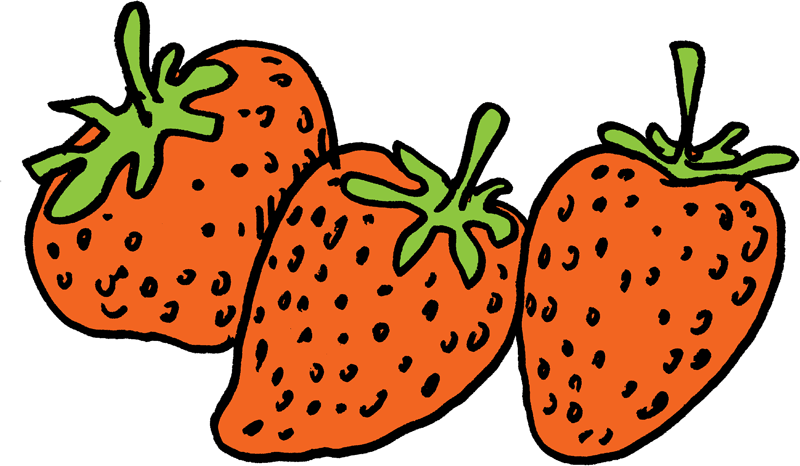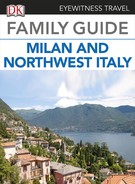< Introducing Milan and Northwest Italy
Where to Eat

Stalls laden with fresh fruit and vegetables at a market
You can’t go too far wrong when eating out with children in Italy, the home of pasta, pizza and ice cream. Myriad pasta shapes and sauces should keep even fussy eaters happy; for those who like to experiment, Italian children’s favourites such as polpette (meat balls), polenta and arancini (deep-fried rice balls) may attract new fans. Add the welcoming attitude to children among hosts, and the chances are all members of the family will enjoy eating out.
Practical information
Lunch (pranzo) is usually served noon–3pm, depending on where you are in the country – everything happens about an hour later in summer in the south. In resort areas a few restaurants stay open until the evening. Dinner (cena) is usually served 7pm–midnight. Most eateries close one day a week, although in popular tourist areas many open seven days in summer.
In many restaurants a cover charge (coperto) will be added to the bill (conto) and, in some, a service charge will be included too. Where it is not, you could leave a small tip (usually up to 10 per cent).
Types of restaurant
Traditionally a trattoria and an osteria offered simple, economical home-style cooking (cucina casalinga), but today the names are also used by smarter establishments to illustrate their interest in reviving traditions and sourcing quality ingredients. A ristorante was once a smart restaurant, but this has become a pretty generic term. An enoteca is a wine bar, which may also serve snacks or meals. If you are heading to a pizzeria look out for one with a forno a legna (wood-burning oven), which makes crispier and tastier pizzas than standard ovens. Anywhere with a garden or terrace will of course appeal to children – and their parents.
In cafés and bars it is cheapest to eat and drink standing at the bar. You will pay a little extra to sit at a table. There are also substantial supplements for eating outside at tables on a pavement terrace or in a piazza.
Courses
Italian meals traditionally have four courses, beginning with an antipasto, or starter. This is followed by the primo, or first course (pasta, risotto or soup). The secondo is the meat or fish course, with a contorno (vegetable or salad) served on a separate plate. Last course is the dolce (dessert), unless you opt for formaggi (cheeses). House wines vary, but a quarto (quarter), mezzo (half) or one-litre caraffa (carafe) will always be drinkable. For children, order acqua minerale, con or senza gas (fizzy or still mineral water), or spremuta (freshly squeezed juice).
Catering for children
All but the very smartest restaurants will be happy to welcome children, even late into the evening. Special requests, such as heating up baby food and asking for food to share (da dividere), will usually be catered for. However, highchairs (seggioloni) and changing facilities (fasciatoi) are uncommon outside tourist spots. Although welcome, children will be expected to sit at the table and not to run around.
Pasta al pomodoro (pasta with tomato sauce) is the fail-safe Italian alternative to a children’s menu, which rarely exists, but carbonara (bacon and egg), amatriciana (bacon and tomato) and pesto are just some of the other child-friendly sauces. Those with an aversion to tomato can choose rice or pasta in bianco (white), which comes plain with grated cheese, or pizza bianca. Food allergies other than gluten-intolerance (celiachia) are less readily understood, as are religious and cultural dietary choices, so be prepared with the right vocabulary to explain. Celiacs should download a free translation card from www.celiactravel.com/cards.
Breakfast
Breakfast (prima colazione) in Italy usually consists of a bowl of milk, milky coffee or hot chocolate, orange juice and a choice of pastries, including croissants (cornetti) or brioches, plain or filled with jam (marmellata), custard (crema) or chocolate (cioccolato). In some hotels there is likely to be a buffet that also includes hams and cheeses. If breakfast is not included in your hotel stay, a good alternative is to eat at a local bar, an enjoyable Italian institution.
Picnics
Putting together a picnic is one of the best ways to try local produce. Find a delicatessen (alimentari) to buy cheese, ham or olives; often they will put together filled rolls (panini) for you. Bakeries (il forno) usually offer focaccia and little pizzas as well as bread. Greengrocers (fruttivendolo) are packed with seasonal fruits and vegetables. Weekly markets offer stall upon stall of fresh vegetables and fruit plus local smallholders with cheese and home-cured salami. There is often also a van or two selling roast chicken, porchetta (roast pork) or arancini (deep-fried rice balls). Italian supermarkets also stock good-quality fresh produce.
Mountain regions may offer picnic areas with outside grills, and around lakes there are free beaches. In towns there are benches in shady corners of piazzas or parks.
Kids’ Corner
How to buy an ice cream in Italy

Find a shop with a queue of Italians outside (locals will know the best place), ideally advertising home-made ice cream (gelato artigianale). Then choose between a cone or cup (cono or coppetta) and select from the colourful array of flavours. You can ask for a taste (posso assaggiare?) and to combine two flavours. In some places you may be offered cream (panna) to top it off. Child-sized cones are often available too. Here are some of the flavours you’ll find:
- Amarena cream with cherries
- Bacio chocolate and hazelnuts
- Cannella cinnamon
- Cioccolato al latte milk chocolate
- Cioccolato all’arancia chocolate with orange
- Cioccolato con peperoncini chocolate with spicy chilli
- Cioccolato fondente dark chocolate
- Cocco coconut
- Crema egg custard
- Fior di latte sweet cream
- Fragola strawberry

- Frutti di bosco fruits of the forest
- Gianduja milk chocolate with hazelnuts

- Lampone raspberry
- Limone lemon
- Liquirizia liquorice
- Malaga rum and raisin
- Mandorla almond
- Mela apple
- Nocciola hazelnut
- Pesca peach
- Pistacchio pistachio
- Puffo bubblegum-flavoured
- Stracciatella cream with dark chocolate bits
- Vaniglia vanilla
- Zuppa inglese trifle
..................Content has been hidden....................
You can't read the all page of ebook, please click here login for view all page.
